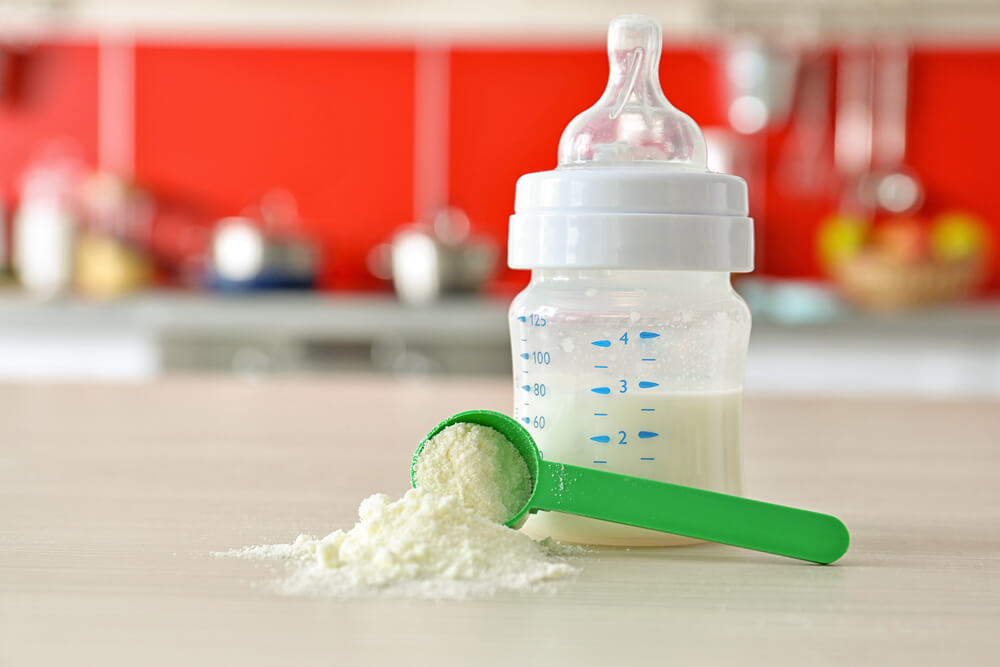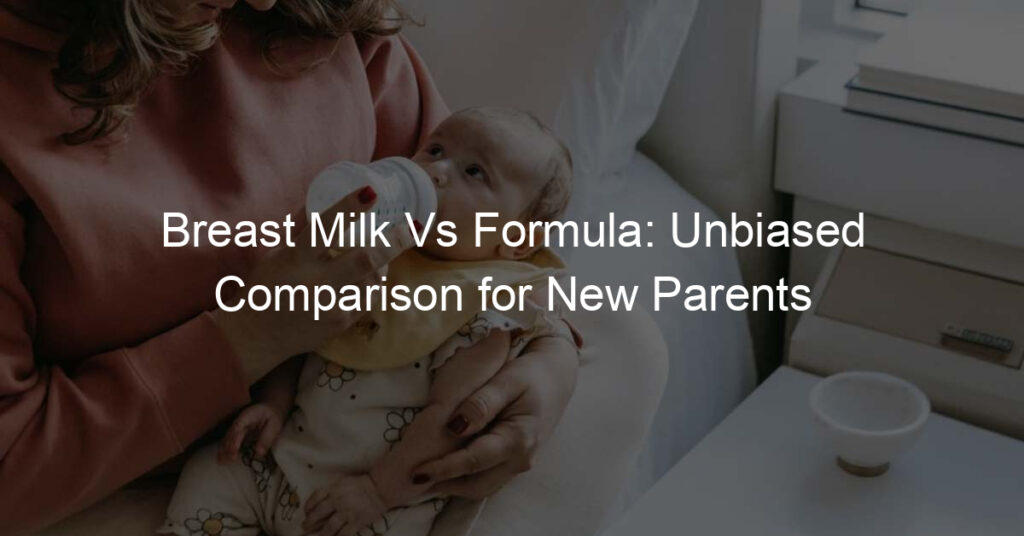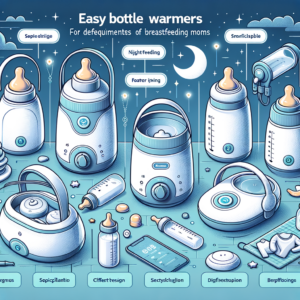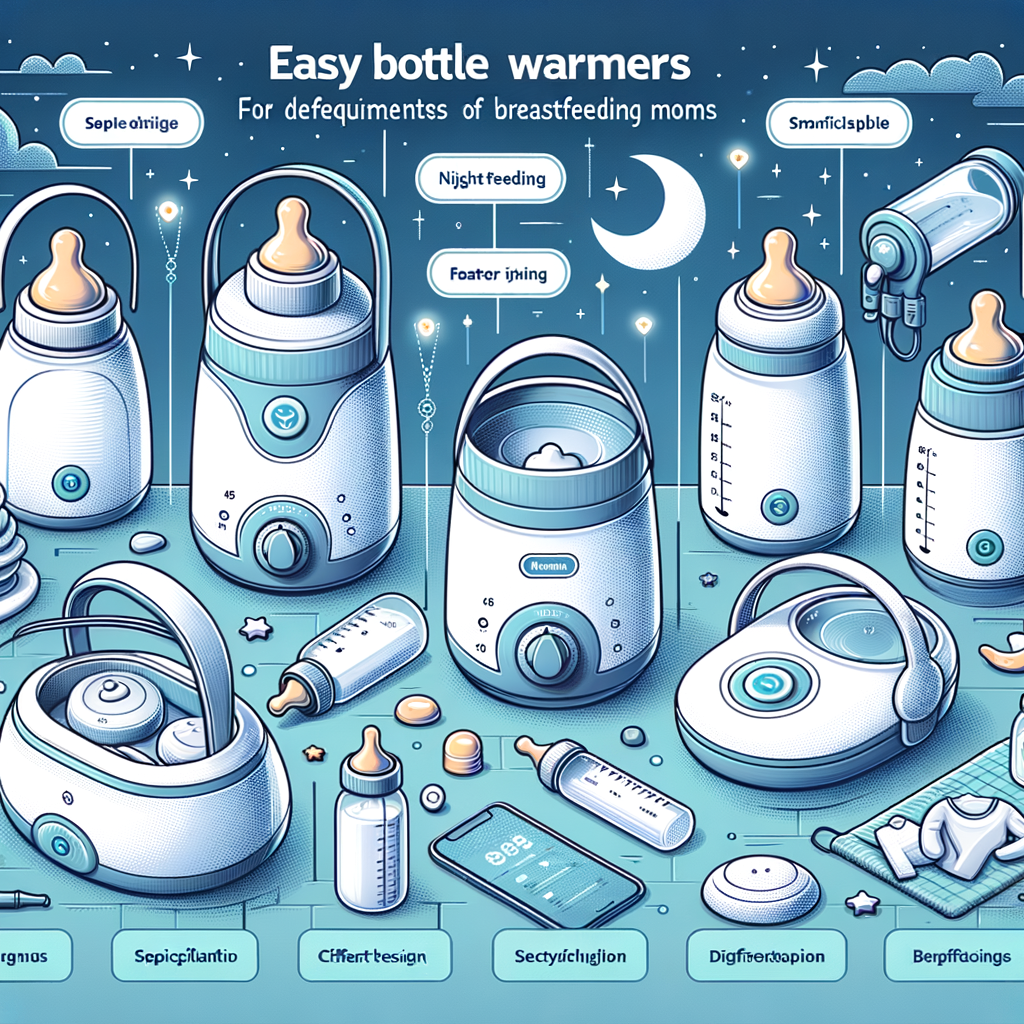As a new parent, one of the crucial decisions to make is about how to nourish your baby. Breast milk and formula are the two main options available today.
In this article, we will explore the differences between breast milk vs formula, their benefits, and the factors that might help you make an informed decision.
Breast milk is a natural source of nutrition designed to meet a baby’s needs for the first months of life, containing a variety of nutrients, antibodies, and growth factors that support a baby’s development.
On the other hand, infant formula is a manufactured product designed to act as a substitute for breast milk, formulated to provide the necessary nutrients for a baby’s growth and development.
When choosing between breast milk and formula, it’s essential to consider your baby’s health, your lifestyle, and your personal preferences. Each option has its pros and cons, and ultimately, the best choice may depend on a combination of factors unique to your situation.
Key Takeaways
- Breast milk and formula are the main options for infant nutrition, with each having benefits and drawbacks.
- Breast milk provides natural nutrients and antibodies, while formula offers convenience and flexibility.
- Personal circumstances and preferences will play a significant role in your feeding decision.
Breast Milk Vs Formula

Breast milk is the natural milk produced by a mother’s mammary glands to feed her infant. It is the primary source of nutrition for newborns and provides essential nutrients, antibodies, and hormones that contribute to the healthy growth and development of a baby.
I’ve learned that breast milk changes as the baby grows, adapting to their nutritional needs.
Formula, also known as infant formula or formula feed, is a manufactured alternative to breast milk. It is designed to mimic breast milk’s nutritional composition and is typically made from cow’s milk, soy protein, or other protein sources.
Formula is usually fed to infants using bottles, and it can be a primary or supplementary source of nutrition. Various types of formula are available, catering to infants with specific needs, such as allergies or intolerances.
When comparing breast milk and formula, it’s essential to consider their nutritional differences and benefits. Below is a comparison of some key nutrients and elements present in both breast milk and formula:
| Nutrient/Element | Breast Milk | Formula |
|---|---|---|
| Proteins | Rich in whey proteins that are easily digestible for infants | Rely on casein and soy proteins, which may be harder to digest |
| Fats | Contain long-chain polyunsaturated fatty acids (LCPUFAs) crucial for brain and neural development | Formulas often include LCPUFAs, but absorption can vary, and some formulations may lack these fatty acids |
| Carbohydrates | Contains lactose and oligosaccharides to aid digestion and support gut health | Typically contain lactose, but some formulas use corn syrup, maltodextrin, or other carbohydrates |
| Immune Benefits | Offer antibodies, hormones, and enzymes to protect against infections and allergies | Lack of the natural immune components found in breast milk |
In addition to the nutritional differences, there are practical aspects to consider. Breast milk is always available at the right temperature and requires no preparation. On the other hand, formula feeding involves preparing bottles, which can be time-consuming, and parents must ensure that the formula is safely stored and mixed correctly.
While both breast milk and formula provide essential nutrients for an infant’s growth and development, each option comes with its own unique benefits and challenges. Ultimately, the choice between breast milk and formula depends on a variety of factors, including personal preferences, medical conditions, and individual circumstances.
Nutritional Content

When comparing breast milk and formula, it’s important to consider the nutritional content of each. I’ll start by briefly discussing the primary components of each: nutrients, protein, fat, vitamins, minerals, carbohydrates, lactose, calories, and cholesterol.
In terms of nutrients, breast milk is designed to provide infants with everything they need for optimal growth and development. It contains a perfect balance of proteins, fats, carbohydrates, and other essential nutrients.
The formula, on the other hand, is created to mimic breast milk as closely as possible and contains many of the same essential nutrients.
Protein is crucial for a baby’s growth and development. In breast milk, it’s present in the form of whey and casein. The ratio of whey to casein in breast milk is around 60:40, making it easy for babies to digest.
The formula typically has a different protein ratio, with some containing more casein, which can be harder for infants to digest.
Fat is a significant source of energy for infants, and both breast milk and formula contain fat. The fat in breast milk is of high biological value and is easier for a baby to absorb. On the other hand, the formula contains a combination of vegetable oils as a fat source, which can be slightly less digestible for some babies.
Vitamins and minerals are essential for overall growth and bodily function. Breast milk naturally contains most of the necessary vitamins and minerals, and sometimes more than formula.
Nevertheless, it can be lower in vitamin D, which is why it’s recommended for breastfeeding mothers to supplement their children with vitamin D drops. The formula is fortified with vitamins and minerals, including vitamin D, to meet the baby’s needs.
Carbohydrates are a primary source of energy for babies. Lactose, the main sugar in breast milk, is present in large amounts, aiding in calcium absorption and promoting healthy gut bacteria. Most formulas contain carbohydrates, primarily in the form of lactose. Yet, some formulas use alternative sugars or carbohydrates for babies who are lactose intolerant or have other sensitivities.
Regarding calorie content, breast milk has approximately 22 calories per ounce, while formula generally has about 20 calories per ounce. The calorie count in breast milk can vary depending on the mother’s diet and the stage of lactation.
Lastly, cholesterol is present in breast milk but not typically found in formula. Cholesterol is necessary for brain development and the formation of hormones and cell membranes. Although the absence of cholesterol in formula may seem concerning, it is not considered a significant issue since babies can produce cholesterol from other sources.
In summary, both breast milk and formula offer essential nutrients for a baby’s growth and development. While breast milk is naturally designed to meet a baby’s needs, formula provides a safe and effective alternative.
Each family should decide what works best for their individual situation.
Health Implications of Breastfeeding and Formula Feeding

Physical Health
Breast milk provides valuable antibodies that can protect infants from various health issues, such as infections and illnesses. For instance, human milk contains necessary proteins and oligosaccharides, which can contribute to a healthy digestive system.
As a result, breastfed infants may experience fewer ear infections, respiratory infections, and cases of meningitis compared to those fed with formula. Additionally, breastfeeding has been associated with a lower risk of developing allergies, type 2 diabetes, and certain cancers such as leukemia.
While formula companies have made strides in mimicking the composition of breast milk, infant formulas still lack some crucial components. Regardless, the formula can provide essential carbohydrates, proteins, and fats needed for an infant’s development.
Formula-fed babies may be more prone to constipation and gassiness due to their digestive systems adjusting to processed proteins. Despite this, hypoallergenic formulas are available for infants with allergies, and the FDA regulates all infant formulas to ensure their safety and nutritional adequacy.
Cognitive Development
Breast milk contains important nutrients that contribute to brain development, notably the beneficial fatty acids required for cognitive growth. Research has suggested that breastfed infants might have a slight edge in areas like language development and intelligence.
However, this area is still under debate, as some studies have found no significant differences in cognitive outcomes between breastfed and formula-fed infants.
Psychological Impact
Breastfeeding can have a positive impact on both mother and child. The act of lactation triggers the release of the hormones prolactin and oxytocin, which help create maternal bonding and may even alleviate postpartum depression.
Nighttime feedings, though challenging, provide additional opportunities for bonding and emotional closeness.
For mothers who are unable to breastfeed or choose not to, they may experience feelings of guilt or inadequacy. However, it is important to emphasize that using formula does not diminish the mother-child connection as long as time for bonding is spent during feeding sessions.
In conclusion, there are both benefits and drawbacks to breastfeeding and formula feeding. Ultimately, the decision should be based on individual circumstances, needs, and preferences.
Ease and Convenience of Breastfeeding Vs Formula Feeding

As a parent, I understand that it’s essential to weigh the ease and convenience factors of breastfeeding and formula feeding. Let’s begin by examining breastfeeding. It is incredibly convenient as it is always readily available, and there is no need for preparation or sterilization.
The process is free, and breast milk provides the perfect blend of nutrients, hormones, and antibodies for my baby’s development. Despite these advantages, it’s important to consider that exclusive breastfeeding can be challenging due to initial difficulties, ongoing breastfeeding scheduling, and potential health issues, such as low vitamin D levels.
On the other hand, formula feeding can also be convenient. Ready-to-use formulas offer an on-the-go option for parents, especially when traveling or in situations where it isn’t easy to nurse privately. Powdered formulas allow for customization when measuring the amount needed for the baby, depending on age and dietary requirements.
Nevertheless, formula feeding has its drawbacks. The ongoing cost of the formula can be significant and requires ample space for storage. Further, the preparation of the formula involves having clean water, bottles, and equipment to ensure my baby’s safety.
When it comes to convenience, both breastfeeding and formula feeding have their pros and cons. Let’s look at them side by side:
Breastfeeding:
- Pros: Always available, no preparation necessary, free, offers ideal nutrients, hormones, and antibodies
- Cons: Potential initial difficulties, need for a scheduled plan, possible health concerns (e.g., low vitamin D levels)
Formula Feeding:
- Pros: Ready-to-use options, customizable powdered formulas, convenient when privacy is required
- Cons: Costly, requires storage space, preparation tools needed (e.g., clean water, bottles, sterilization equipment)
In the end, the choice between breastfeeding and formula feeding will depend on personal preferences, lifestyle, and specific circumstances. What’s most important is that my baby receives proper nourishment and care to support their growth and development.
Role of Organizations and Expert Advice

As a knowledgeable individual in the breast milk vs. formula debate, I have encountered several organizations and experts providing advice on this topic. The American Academy of Pediatrics (AAP), the World Health Organization (WHO), the American Medical Association (AMA), and other health organizations all have their recommendations.
The American Academy of Pediatrics strongly supports breastfeeding. They recommend exclusive breastfeeding for the first six months of a baby’s life and then the introduction of solid foods while breastfeeding continues until at least one year.
The AAP believes that breastfeeding offers numerous health benefits for both the baby and the mother.
Similar to the AAP, the World Health Organization also endorses breastfeeding. The WHO suggests exclusive breastfeeding for up to six months, followed by the introduction of nutritious complementary foods while continuing to breastfeed for up to two years or beyond.
They consider breastfeeding a crucial public health issue and emphasize the promotion and protection of this practice.
In recent years, both the American Medical Association and various other health organizations have echoed their support for breastfeeding, recognizing the health advantages it provides.
Furthermore, these organizations offer guidance for mothers who are unable to breastfeed or choose not to, ensuring that they have access to safe and nutritious formula options.
I am aware that several factors can influence a mother’s decision to breastfeed or use formula. These can include lack of support, misinformation, medical issues, or personal preference.
Health organizations and expert advice play a crucial role in educating and advocating for mothers, so they can make informed decisions about what is best for them and their babies.
Challenges and Considerations
As I dive deeper into the topic of breast milk vs. formula, there are several challenges and considerations that parents must face when deciding which option is the best for their baby’s nutrition and growth.
One of the main factors to consider is the infant’s immune system. Breast milk is known to provide vital antibodies and immune-boosting substances that help protect babies from various infections. On the other hand, the formula can still provide essential nutrients, but it lacks the specific antibodies that promote a strong immune system.
In terms of bonding, breastfeeding can offer a unique and intimate experience for both mother and child. It not only provides physical nourishment but also fosters a strong emotional bond. However, this shouldn’t diminish the fact that formula-feeding parents can also create a nurturing and close connection during feeding times.
When assessing infant nutrition, breast milk is often regarded as the gold standard, particularly during the first six months of life. It is designed to meet the specific needs of infants and provides a perfect balance of nutrients.
Nonetheless, formula companies continually strive to replicate breast milk’s composition, and many brands offer adequate nutrition for growing babies.
Considering IQ and cognitive development, some studies suggest that breastfed babies may have a slight advantage in cognitive abilities compared to their formula-fed counterparts. Yet, it is essential to note that numerous factors can influence a child’s intelligence, and the choice of breastfeeding or formula feeding may not be the sole determinant.
The introduction of solid foods usually occurs around six months of age. For both breastfed and formula-fed infants, this transition should be gradual and tailored to each baby’s specific needs and preferences.
When it comes to chronic conditions, research has indicated that breastfeeding may reduce the risk of certain illnesses, such as type 2 diabetes, obesity, and even some cancers. Although formula can’t provide the same potential protective effects in these areas, parents should still prioritize their child’s overall health and well-being through a balanced lifestyle.
Lastly, it’s crucial for parents to seek support from healthcare professionals, family, and friends in making an informed decision on how to nourish their child. Whether a parent chooses to breastfeed or use formula, facing challenges and finding solutions along the way is part of the journey.
Ultimately, the decision should be based on what is best for the baby and the family.
Frequently Asked Questions
What are the main nutritional differences between breast milk and formula?
Breast milk and formula both provide essential nutrients for a baby’s growth and development. However, breast milk contains certain immune-boosting substances and proteins that are not found in formula. I have noticed that breast milk’s composition can change according to the baby’s needs, while formula has a consistent nutrient profile.
Additionally, breast milk contains specific fats that support brain development, which may not be present in all formulas.
How do breastfeeding and formula feeding affect a baby’s long-term health?
Breastfeeding has been linked to several long-term health benefits, such as reduced risk of certain infections, lower rates of childhood obesity, and better cognitive development. On the other hand, formula feeding may not provide these same benefits, but it does offer complete and balanced nutrition for infants who cannot receive breast milk.
I want to clarify that while breastfeeding may offer some advantages, formula-fed babies can still grow up healthy and strong.
Are there any risks associated with formula feeding?
Some risks associated with formula feeding can include a higher risk of infections, certain allergies, and changes in gut bacterial composition. This is because formula lacks the immune-enhancing substances found in breast milk. Regardless, I must emphasize that the overall risk is relatively low, and using a safe and age-appropriate formula can minimize potential hazards.
What are the benefits of formula feeding?
There are several benefits of formula feeding, such as flexibility in the feeding schedule, the ability to share feeding responsibility and knowing the exact amount of milk consumed by the baby. Moreover, formula feeding can be a suitable alternative when breastfeeding is not possible or when specific health concerns arise.
Some mothers may also choose formula feeding to maintain their baby’s nutritional needs while returning to work or due to personal preferences.
How do breast milk and formula affect a baby with reflux?
For a baby with reflux, breast milk might be easier to digest because it is easily broken down and absorbed by the baby’s body. However, I have noticed that some formula-fed babies with reflux may benefit from specialized formulas that are designed to be thicker, preventing reflux symptoms.
It is essential to consult your pediatrician to determine the appropriate feeding method and solution for a baby with reflux.
What are some downsides to formula feeding?
One major downside of formula feeding is the cost, as formula can be expensive compared to breast milk. Moreover, the preparation and storage of formula can be time-consuming and require proper hygiene practices. Another downside is the potential for environmental impact due to the manufacturing and packaging of formula products.
Finally, formula-fed infants may not receive the same immune-boosting benefits found in breast milk, which could affect their overall long-term health.














